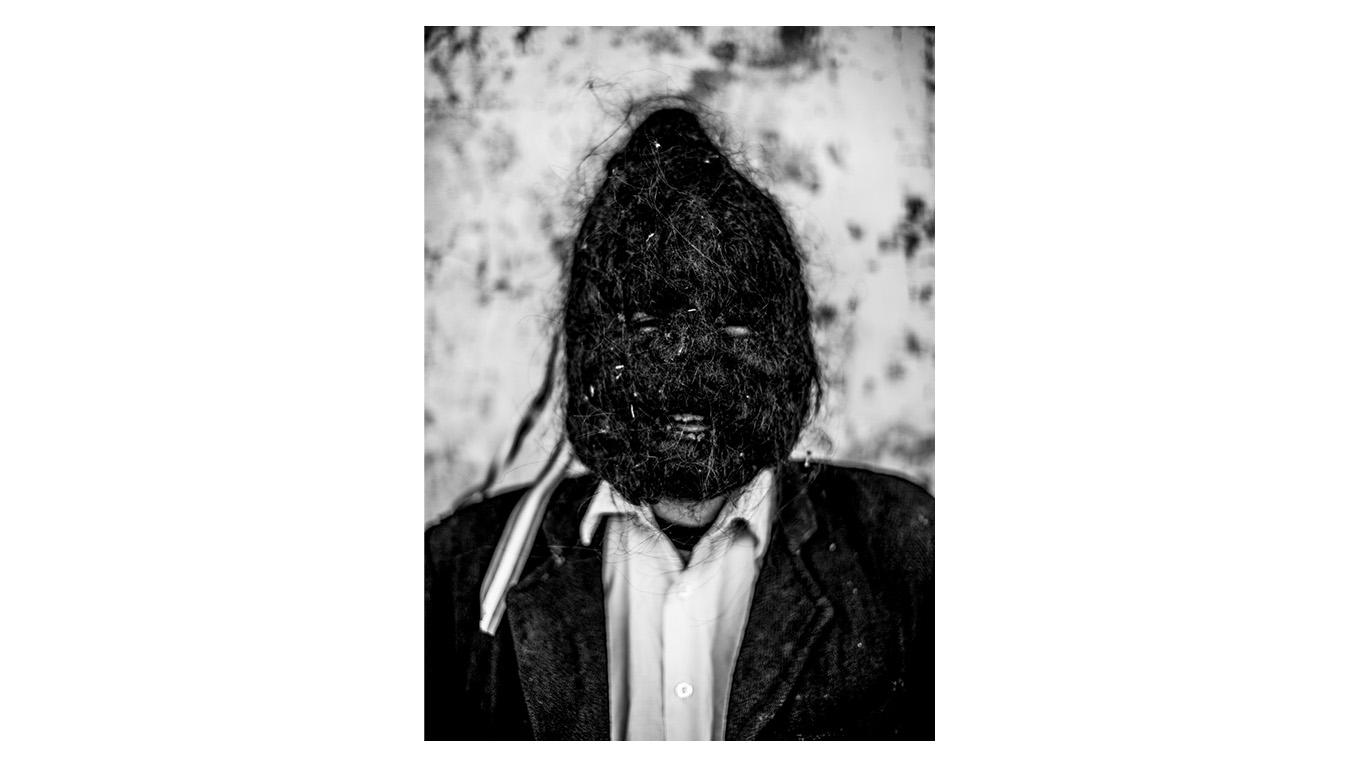Private Story
Allegory Against Identification
Dorota Biczel, Ph.D.
In Musuk Nolte’s photographs, light pulls out the subjects from an abysmal darkness. In many dramatic images, such as the series Oráculo and Sombra de isla, it looks as if the light had labored to render form visible, having penetrated great depths and distances to encounter and define the contours and textures of people, objects, and matter. Take, for example, a long and wide row of candles lit during the ceremony of the return of the remains of the forcibly disappeared to their families in Ayacucho: it appears as a constellation of blurry white flecks against velvety black background as if it were a remote galaxy or a falling, disintegrating firework. The artist likens this effect to the great tradition of the early-twentieth-century photography in Peru, exemplified by Martin Chambí and Brothers Vargas. Especially, one can think back to the latter’s noirish nocturnes, suffused with the air of tension and an impermeable mystery. In that way, Nolte inscribes himself into a distinct heritage—the one he calls “his own” in reference to his adopted country of Peru—and into the lineage of photographic practices that emphatically belong to the so-called non-West. However, I think of his piercing, laboring light as also distinctly Baroque, producing the scenes of great theatricality, in which seemingly ordinary events acquire an iconic status and even quotidian gestures and objects are charged with a potent symbolic inflection. Nolte’s images come across as allegories, yet his allegories cannot be easily named.
For over a decade, Nolte has deftly navigated distinct spaces of production, presentation, and circulation, and has successfully inserted himself into the realms of photojournalism, book publishing, “fine art photography,” and “contemporary art” with his prolific and diverse body of work. In the vast majority, the portfolio assembled for Contact Sheet consists of the images that in one way or the other seem to highlight the thorny problem of the nation and the “national” in Peru, which has historically been perceived as profoundly and irremediably fractured. I refer here to the range of political and social processes that scholar Mark Thurner summarized as a transformation ‘from two republics [creole and “Indian”] to one divided.’ Thus, Nolte’s photographs gesture to incessant political unrest (La resistencia del silencio, La impermanencia del grito), the Internal Conflict of 1980–2000 (Apolítico, El idioma de los huesos), culturally poignant historic sites and objects (Oráculo, Apolítico, Veta Matriz), and the unplanned, uncontrollable, and inequitable growth of the country’s capital, Lima (Historia del agua en el desierto), which—for some people—serves as the synecdoche of the entire Peruvian history. His selection carefully avoids those bodies of work that could be classified as anthropological, travel, or conservation photography, and—except for Historia del agua en el desierto—it also shies away from the documentary modes of representation.
If the medium of photography amounts to the trafficking of gazes and projections, and if so-called documentary photography in particular has historically often sought to meet and satisfy the gaze of “outside” and ill-informed observers by delivering and confirming expected information, Nolte’s body of work frustrates such expectations by what he chooses to show and not to show in the context of a US-based publication. Most importantly, he refutes any notion of a legible multiethnic and polycultural nation-state. In this sense, his rich bodies of work realized in the Amazon and Central Andes are conspicuously absent from the portfolio. What I mean to say by stating this fact is that if a “Western” viewer or reader is searching for an “authentic” Peruvian here, they are not going to find him/her/them. Instead, Nolte confronts viewers with the images that, although ostensibly loaded with the weighty icons and symbols, refuse to be read or decoded. To this end, the untitled image from the series Apolítoco that opens his selection is perhaps most revealing in its stubborn opacity.
According to its textual description, the photograph depicts a Puno-based ritual dancer wearing the mask representing a “terrorist.” In the lower-third of the image, one can discern a torso garbed in a white shirt overlayed with a lumpy dark suit jacket. However, a human connotation suggested by the body rapidly disappears once one looks up, towards the “head” that constitutes a sharp focal point of the image. There, a viewer is confronted with an ambiguous unfathomable entity: a tenebrous mass, a gourd, or a rock, neither human nor other-than-human. A “terrorist” is a slightly elongated, intensely textured black oval, surrounded by fuzzy black lines and interspersed with small but aggressive white punctuations. A horizontal white almond shape breaks the form’s center right. The middle point of the lower third features an abrupt white slit surrounded by three white points above and below it.
The image resists its textual description and remains beyond recognition as if it were an unidentified body of an unknown species. This, in a gist, constitutes a critical contribution of Nolte: to resist easy naming and encounter “the other” as if you were starting from a blank slate. The icons and symbols are yet to be made.



